

Compact Muon Solenoid
LHC, CERN
| CMS-PAS-HIN-16-025 | ||
| Measurement of prompt and nonprompt charmonium suppression in PbPb collisions at 5.02 TeV | ||
| CMS Collaboration | ||
| July 2017 | ||
| Abstract: The nuclear modification factors of J/ψ and ψ(2S) mesons are measured in PbPb collisions at a centre-of-mass energy per nucleon pair of √sNN= 5.02 TeV. The analysis is based on PbPb and pp data samples collected by CMS at the LHC in 2015, corresponding to integrated luminosities of 464 μfb−1 and 28 pb−1, respectively. The measurements are performed in the |y|< 2.4 rapidity range as a function of centrality, rapidity and transverse momentum (pT), from pT= 3 GeV/c in the most forward region and up to pT= 50 GeV/c. Both prompt J/ψ and nonprompt J/ψ (coming from b-hadron decays) are observed to be gradually suppressed with centrality, with a magnitude similar to the one observed at √sNN= 2.76 TeV. No dependence on rapidity is observed, while prompt and nonprompt J/ψ are less suppressed at the lower and higher explored pT. The prompt ψ(2S) is found to be more suppressed than the prompt J/ψ in the entire pT range. | ||
|
Links:
CDS record (PDF) ;
inSPIRE record ;
CADI line (restricted) ;
These preliminary results are superseded in this paper, EPJC 78 (2018) 509. The superseded preliminary plots can be found here. |
||
| Figures | Summary | Additional Figures | References | CMS Publications |
|---|
| Figures | |
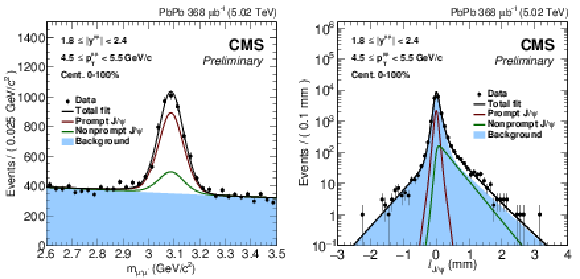
png pdf |
Figure 1:
Invariant-mass spectrum of μ+μ− pairs (left) and pseudo-proper decay length distribution (right) in PbPb collisions for 1.8 <|y|< 2.4, 4.5 <pT< 5.5 GeV/c, all centralities. Also shown is the result of the fit described in the text. |
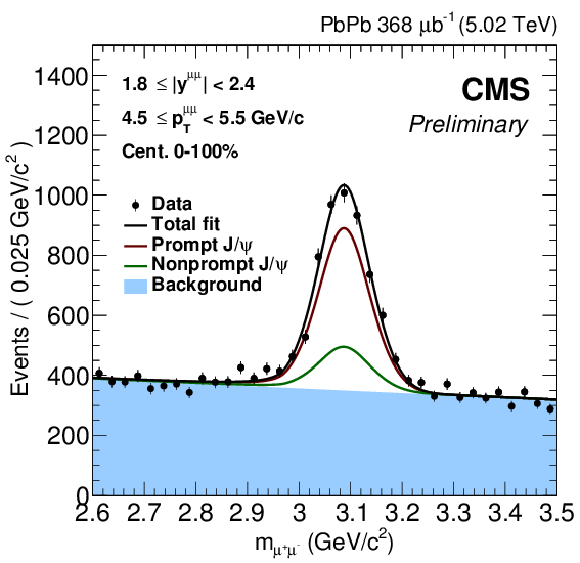
png pdf |
Figure 1-a:
Invariant-mass spectrum of μ+μ− pairs in PbPb collisions for 1.8 <|y|< 2.4, 4.5 <pT< 5.5 GeV/c, all centralities. Also shown is the result of the fit described in the text. |
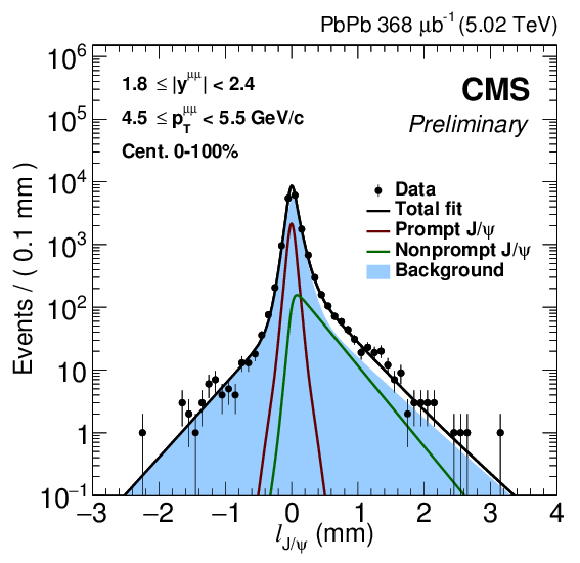
png pdf |
Figure 1-b:
Pseudo-proper decay length distribution in PbPb collisions for 1.8 <|y|< 2.4, 4.5 <pT< 5.5 GeV/c, all centralities. Also shown is the result of the fit described in the text. |
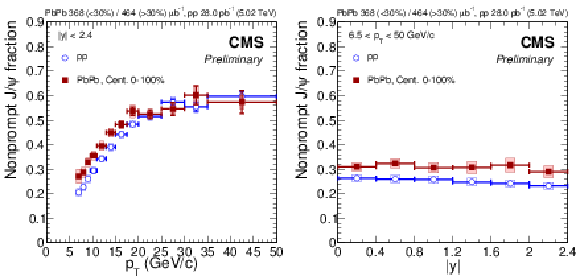
png pdf |
Figure 2:
Nonprompt J/ψ fractions in pp collisions as a function of pT (left) and rapidity (right) for pp and PbPb collisions. The bars (boxes) represent statistical (systematic) point-by-point uncertainties. |
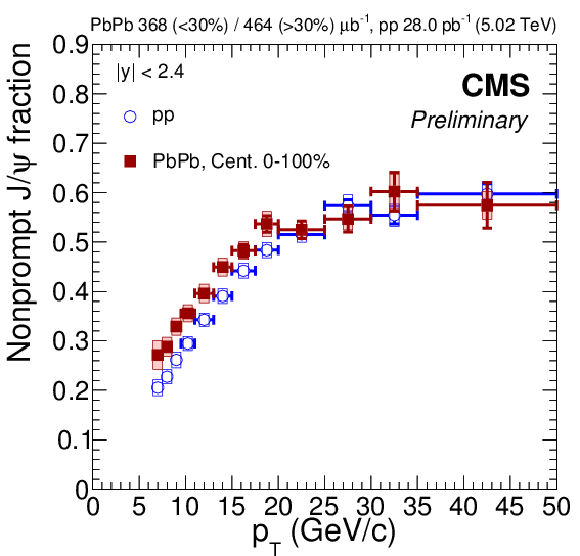
png pdf |
Figure 2-a:
Nonprompt J/ψ fractions in pp collisions as a function of pT for pp and PbPb collisions. The bars (boxes) represent statistical (systematic) point-by-point uncertainties. |
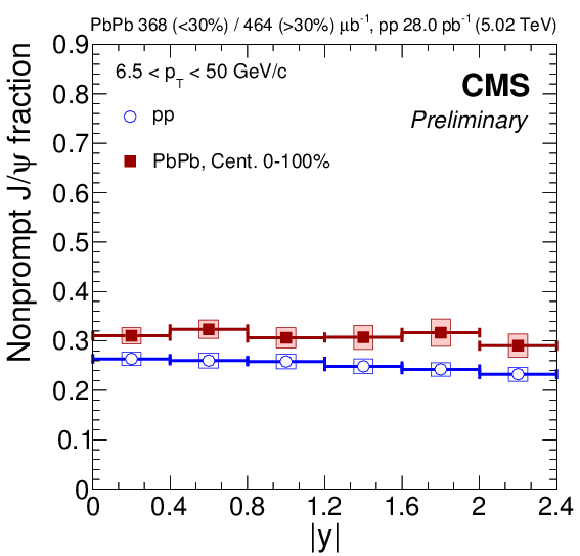
png pdf |
Figure 2-b:
Nonprompt J/ψ fractions in pp collisions as a function of rapidity for pp and PbPb collisions. The bars (boxes) represent statistical (systematic) point-by-point uncertainties. |
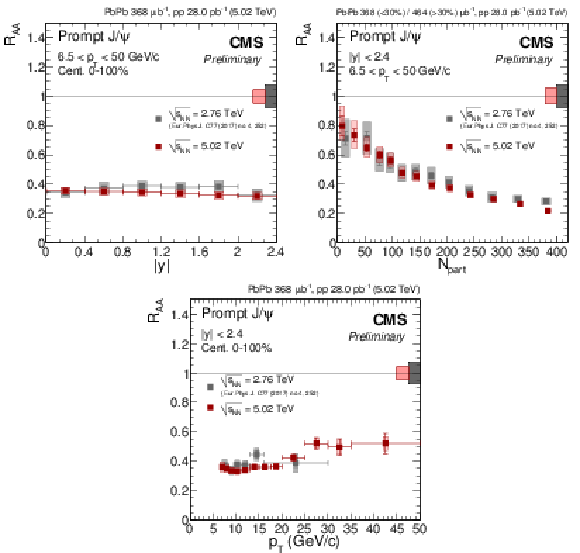
png pdf |
Figure 3:
Nuclear modification factor of prompt J/ψ as a function of rapidity (top left), centrality (top right) and pT (bottom) at √sNN= 5.02 TeV. Results obtained at √sNN= 2.76 TeV are overlaid for comparison [10]. The bars (boxes) represent statistical (systematic) point-by-point uncertainties. The boxes plotted at RAA= 1 indicate the scale of the global relative uncertainties. |
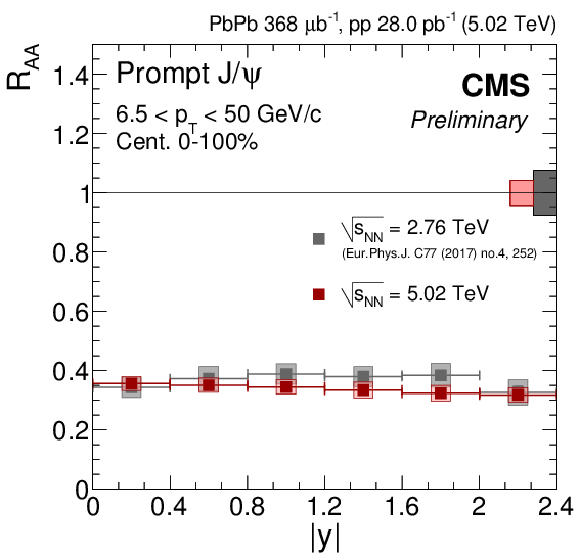
png pdf |
Figure 3-a:
Nuclear modification factor of prompt J/ψ as a function of rapidity at √sNN= 5.02 TeV. Results obtained at √sNN= 2.76 TeV are overlaid for comparison [10]. The bars (boxes) represent statistical (systematic) point-by-point uncertainties. The boxes plotted at RAA= 1 indicate the scale of the global relative uncertainties. |
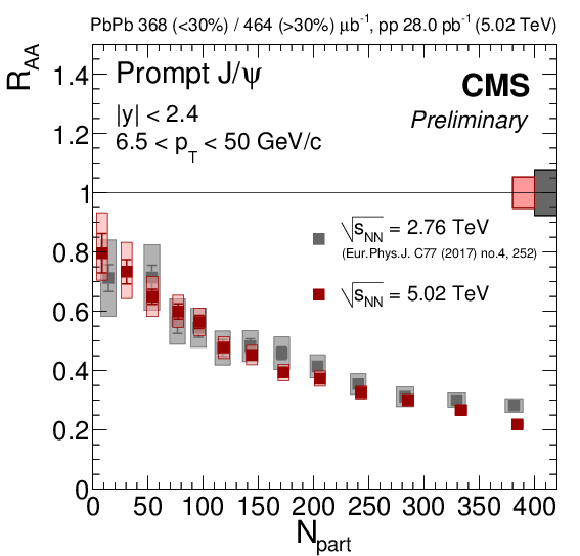
png pdf |
Figure 3-b:
Nuclear modification factor of prompt J/ψ as a function of centrality at √sNN= 5.02 TeV. Results obtained at √sNN= 2.76 TeV are overlaid for comparison [10]. The bars (boxes) represent statistical (systematic) point-by-point uncertainties. The boxes plotted at RAA= 1 indicate the scale of the global relative uncertainties. |
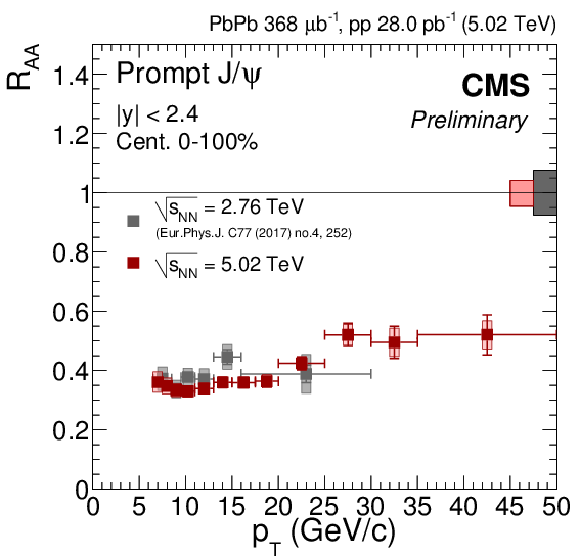
png pdf |
Figure 3-c:
Nuclear modification factor of prompt J/ψ as a function of pT at √sNN= 5.02 TeV. Results obtained at √sNN= 2.76 TeV are overlaid for comparison [10]. The bars (boxes) represent statistical (systematic) point-by-point uncertainties. The boxes plotted at RAA= 1 indicate the scale of the global relative uncertainties. |
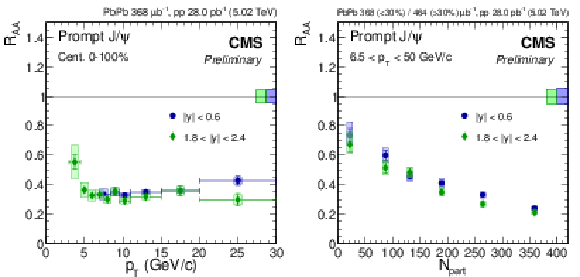
png pdf |
Figure 4:
Nuclear modification factor of prompt J/ψ as a function of pT (left) and centrality (right), in the mid and most forward rapidity intervals. The bars (boxes) represent statistical (systematic) point-by-point uncertainties. The boxes plotted at RAA= 1 indicate the scale of the global relative uncertainties. |
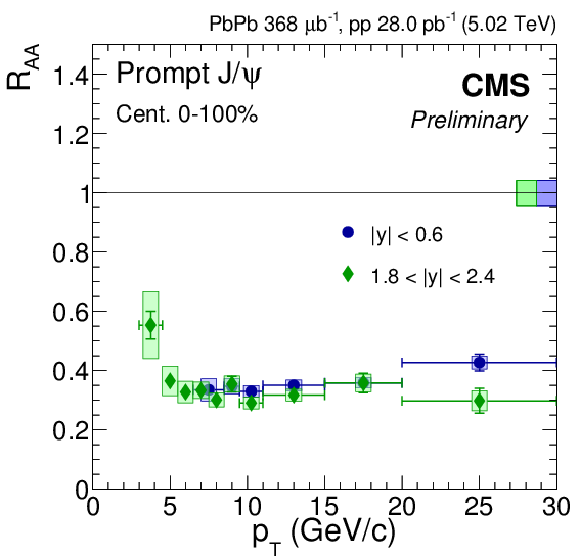
png pdf |
Figure 4-a:
Nuclear modification factor of prompt J/ψ as a function of pT, in the mid and most forward rapidity intervals. The bars (boxes) represent statistical (systematic) point-by-point uncertainties. The boxes plotted at RAA= 1 indicate the scale of the global relative uncertainties. |
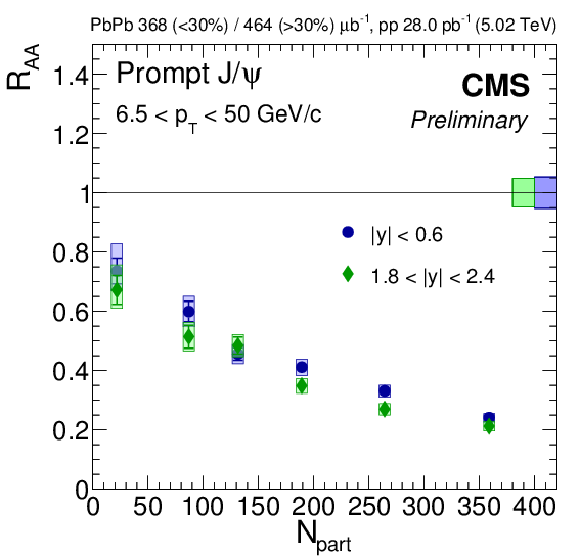
png pdf |
Figure 4-b:
Nuclear modification factor of prompt J/ψ as a function of centrality, in the mid and most forward rapidity intervals. The bars (boxes) represent statistical (systematic) point-by-point uncertainties. The boxes plotted at RAA= 1 indicate the scale of the global relative uncertainties. |

png pdf |
Figure 5:
Nuclear modification factor of prompt J/ψ. Left: as a function of pT in three centrality bins. Right: as a function of centrality at moderate and high pT, in the forward 1.8 <|y|< 2.4 range. The bars (boxes) represent statistical (systematic) point-by-point uncertainties. The boxes plotted at RAA=1 indicate the scale of the global relative uncertainties. |
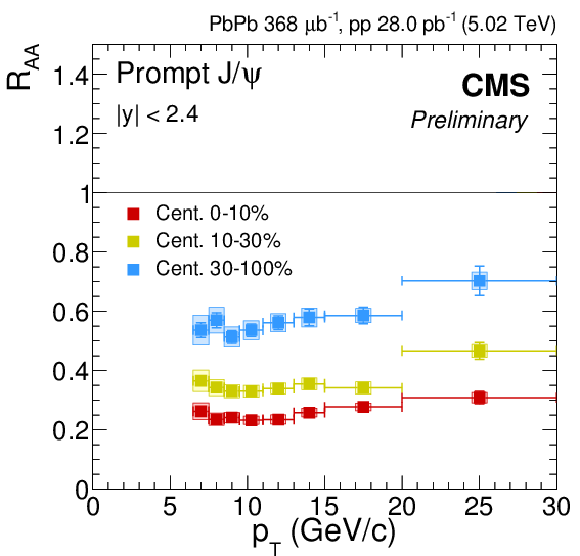
png pdf |
Figure 5-a:
Nuclear modification factor of prompt J/ψ as a function of pT in three centrality bins. The bars (boxes) represent statistical (systematic) point-by-point uncertainties. The boxes plotted at RAA=1 indicate the scale of the global relative uncertainties. |
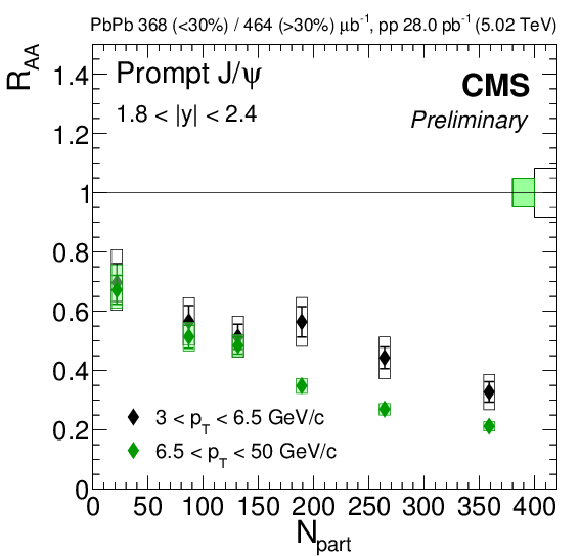
png pdf |
Figure 5-b:
Nuclear modification factor of prompt J/ψ as a function of centrality at moderate and high pT, in the forward 1.8 <|y|< 2.4 range. The bars (boxes) represent statistical (systematic) point-by-point uncertainties. The boxes plotted at RAA=1 indicate the scale of the global relative uncertainties. |

png pdf |
Figure 6:
The nuclear modification factor for the prompt J/ψ and ψ(2S) as a function of centrality (left) and pT (right), at central (top, starting at pT= 6.5 GeV/c) and forward (bottom, starting at pT= 3.0 GeV/c) rapidity. The vertical arrows represent 95% confidence intervals. The bars (boxes) represent statistical (systematic) point-by-point uncertainties. The boxes plotted at RAA= 1 indicate the scale of the global relative uncertainties. |
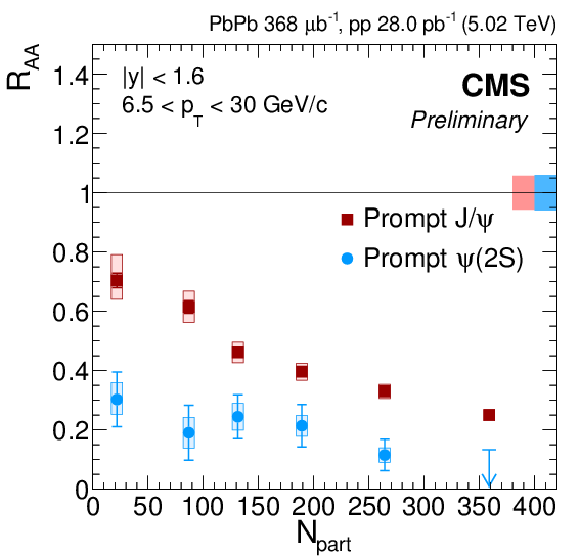
png pdf |
Figure 6-a:
The nuclear modification factor for the prompt J/ψ and ψ(2S) as a function of centrality, at central (starting at pT= 6.5 GeV/c) rapidity. The vertical arrows represent 95% confidence intervals. The bars (boxes) represent statistical (systematic) point-by-point uncertainties. The boxes plotted at RAA= 1 indicate the scale of the global relative uncertainties. |
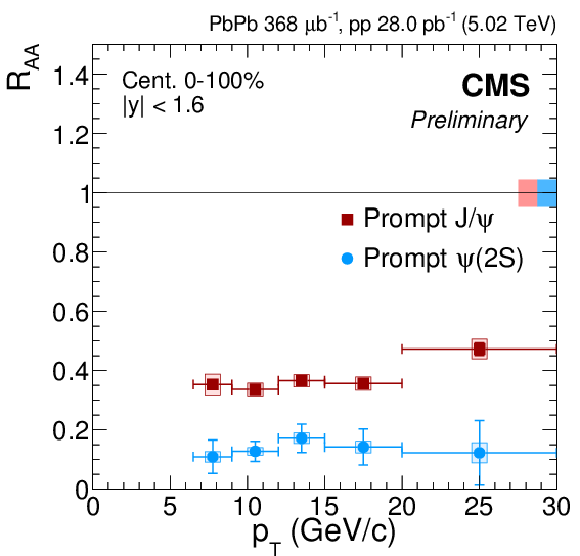
png pdf |
Figure 6-b:
The nuclear modification factor for the prompt J/ψ and ψ(2S) as a function of pT, at central (starting at pT= 6.5 GeV/c) rapidity. The vertical arrows represent 95% confidence intervals. The bars (boxes) represent statistical (systematic) point-by-point uncertainties. The boxes plotted at RAA= 1 indicate the scale of the global relative uncertainties. |
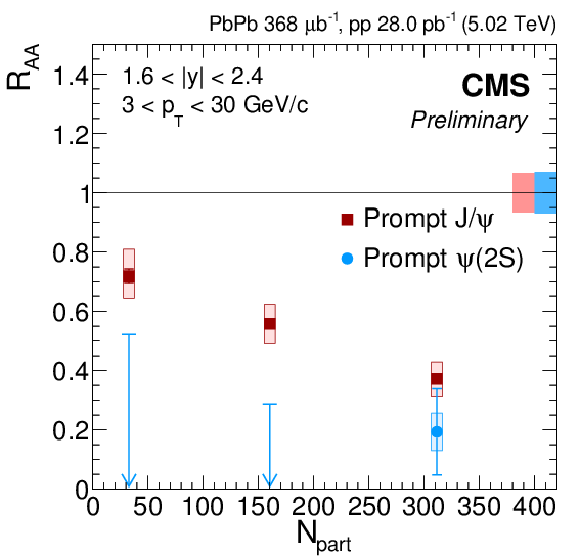
png pdf |
Figure 6-c:
The nuclear modification factor for the prompt J/ψ and ψ(2S) as a function of centrality, at forward (starting at pT= 3.0 GeV/c) rapidity. The vertical arrows represent 95% confidence intervals. The bars (boxes) represent statistical (systematic) point-by-point uncertainties. The boxes plotted at RAA= 1 indicate the scale of the global relative uncertainties. |
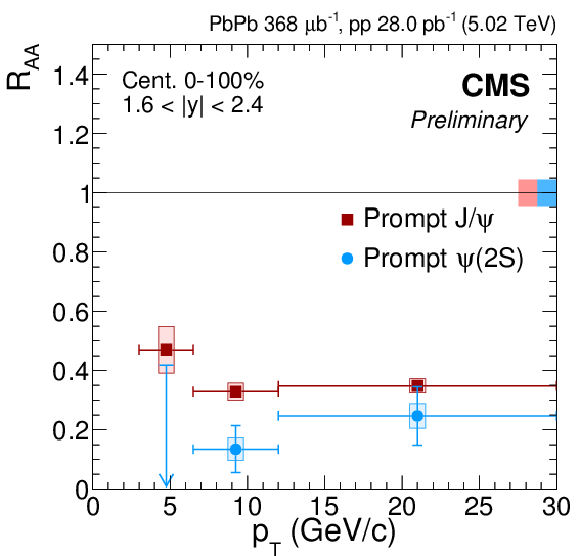
png pdf |
Figure 6-d:
The nuclear modification factor for the prompt J/ψ and ψ(2S) as a function of pT, at forward (starting at pT= 3.0 GeV/c) rapidity. The vertical arrows represent 95% confidence intervals. The bars (boxes) represent statistical (systematic) point-by-point uncertainties. The boxes plotted at RAA= 1 indicate the scale of the global relative uncertainties. |
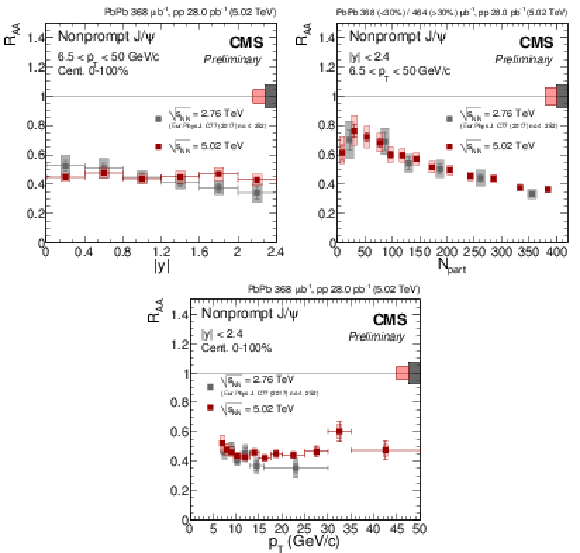
png pdf |
Figure 7:
Nuclear modification factor as a function of rapidity (top left), centrality (top right) and pT (bottom) for the nonprompt J/ψ at √sNN= 5.02 TeV. Results obtained at √sNN= 2.76 TeV are overlaid for comparison [10]. The bars (boxes) represent statistical (systematic) point-by-point uncertainties. The boxes plotted at RAA= 1 indicate the scale of the global relative uncertainties. |
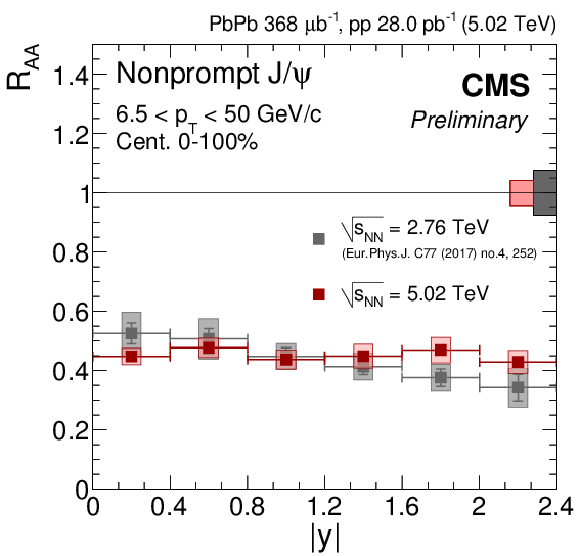
png pdf |
Figure 7-a:
Nuclear modification factor as a function of rapidity for the nonprompt J/ψ at √sNN= 5.02 TeV. Results obtained at √sNN= 2.76 TeV are overlaid for comparison [10]. The bars (boxes) represent statistical (systematic) point-by-point uncertainties. The boxes plotted at RAA= 1 indicate the scale of the global relative uncertainties. |
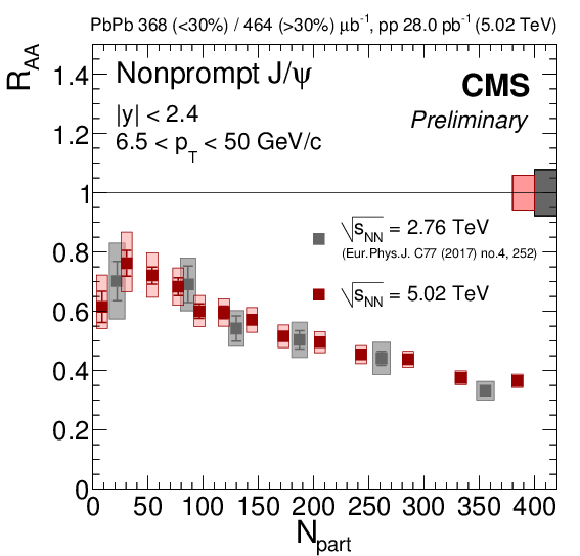
png pdf |
Figure 7-b:
Nuclear modification factor as a function of centrality for the nonprompt J/ψ at √sNN= 5.02 TeV. Results obtained at √sNN= 2.76 TeV are overlaid for comparison [10]. The bars (boxes) represent statistical (systematic) point-by-point uncertainties. The boxes plotted at RAA= 1 indicate the scale of the global relative uncertainties. |
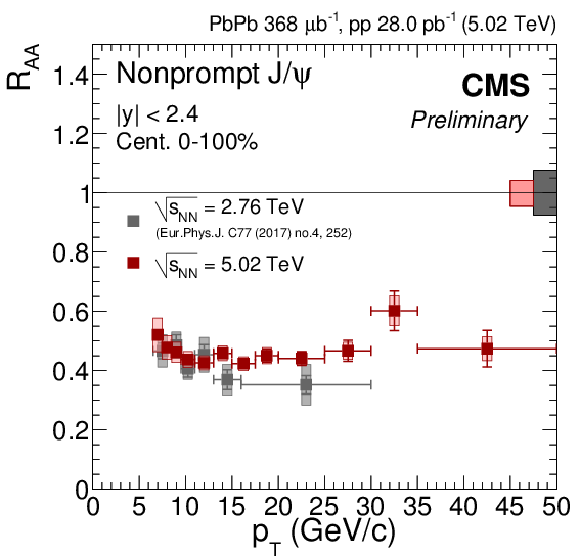
png pdf |
Figure 7-c:
Nuclear modification factor as a function of pT for the nonprompt J/ψ at √sNN= 5.02 TeV. Results obtained at √sNN= 2.76 TeV are overlaid for comparison [10]. The bars (boxes) represent statistical (systematic) point-by-point uncertainties. The boxes plotted at RAA= 1 indicate the scale of the global relative uncertainties. |
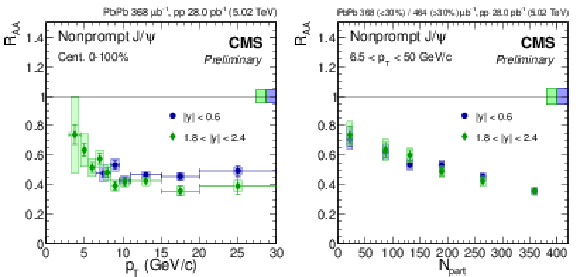
png pdf |
Figure 8:
Nuclear modification factor of nonprompt J/ψ as a function of pT (left) and centrality (right) and in the mid and most forward rapidity intervals. The bars (boxes) represent statistical (systematic) point-by-point uncertainties. The boxes plotted at RAA= 1 indicate the scale of the global relative uncertainties. |
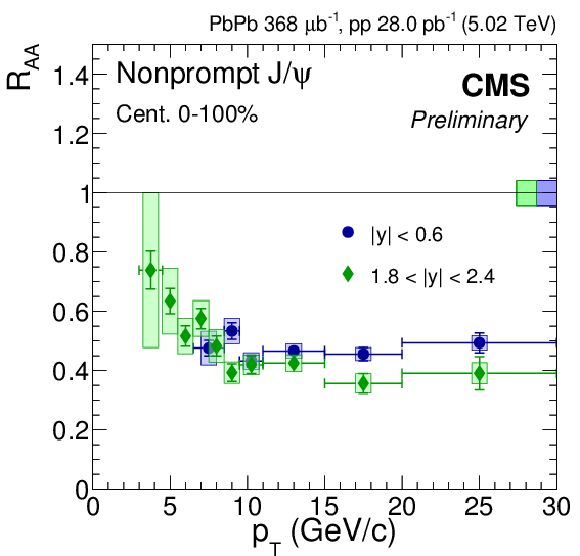
png pdf |
Figure 8-a:
Nuclear modification factor of nonprompt J/ψ as a function of pT and in the mid and most forward rapidity intervals. The bars (boxes) represent statistical (systematic) point-by-point uncertainties. The boxes plotted at RAA= 1 indicate the scale of the global relative uncertainties. |
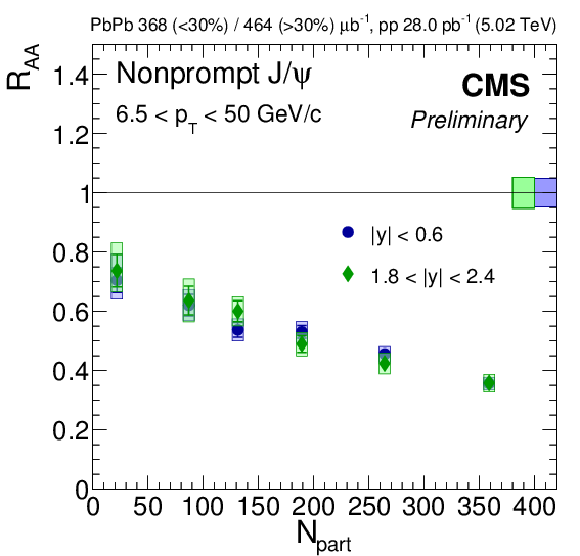
png pdf |
Figure 8-b:
Nuclear modification factor of nonprompt J/ψ as a function of centrality and in the mid and most forward rapidity intervals. The bars (boxes) represent statistical (systematic) point-by-point uncertainties. The boxes plotted at RAA= 1 indicate the scale of the global relative uncertainties. |
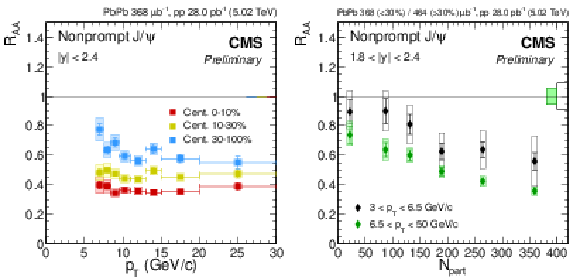
png pdf |
Figure 9:
The nuclear modification factor as a function of pT for the nonprompt J/ψ in two centrality bins. The bars (boxes) represent statistical (systematic) point-by-point uncertainties. The boxes plotted at RAA= 1 indicate the scale of the global relative uncertainties. |
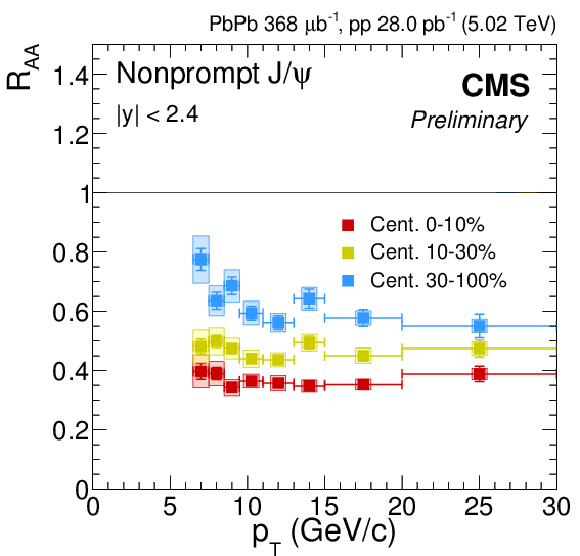
png pdf |
Figure 9-a:
The nuclear modification factor as a function of pT for the nonprompt J/ψ in centrality bin |y|< 2,4. The bars (boxes) represent statistical (systematic) point-by-point uncertainties. The boxes plotted at RAA= 1 indicate the scale of the global relative uncertainties. |
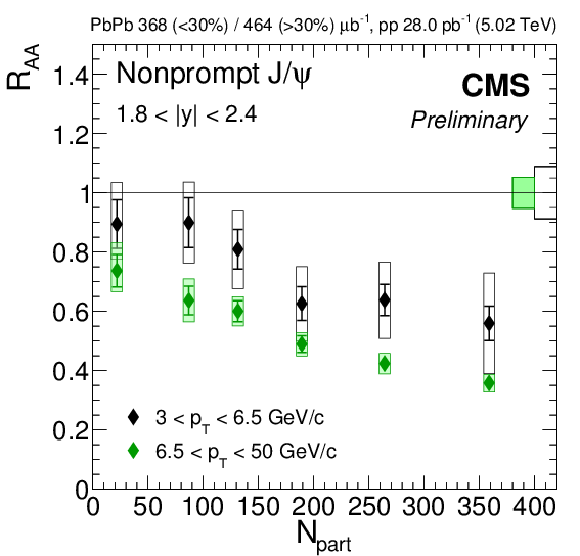
png pdf |
Figure 9-b:
The nuclear modification factor as a function of pT for the nonprompt J/ψ in centrality bin 1.8 <|y|< 2.4. The bars (boxes) represent statistical (systematic) point-by-point uncertainties. The boxes plotted at RAA= 1 indicate the scale of the global relative uncertainties. |
| Summary |
|
Prompt and nonprompt J/ψ production has been studied in pp and PbPb collisions at √sNN= 5.02 TeV, as a function of rapidity, transverse momentum and collision centrality in different kinematic and centrality ranges. Two observables were measured: nonprompt J/ψ fractions and prompt and nonprompt J/ψ nuclear modification factors RAA. The latter show a strong centrality dependence, with an increasing suppression towards central events. No significant rapidity dependence, and a smaller suppression at the lowest and highest pT ranges are observed for both prompt and nonprompt J/ψ. Double differential measurements confirm this observation, also hinting to a larger pT dependence in peripheral events. The measurements are consistent with previous results at √sNN= 2.76 TeV. The prompt ψ(2S) RAA has also been measured in PbPb collisions at √sNN= 5.02 TeV, as a function transverse momentum and collision centrality in two different rapidity ranges. The results show that the ψ(2S) is more suppressed than the J/ψ mesons for all the kinematical ranges studied. No pT dependence is observed within the current uncertainties. Hints of an increasing suppression with collision centrality are also observed. |
| Additional Figures | |
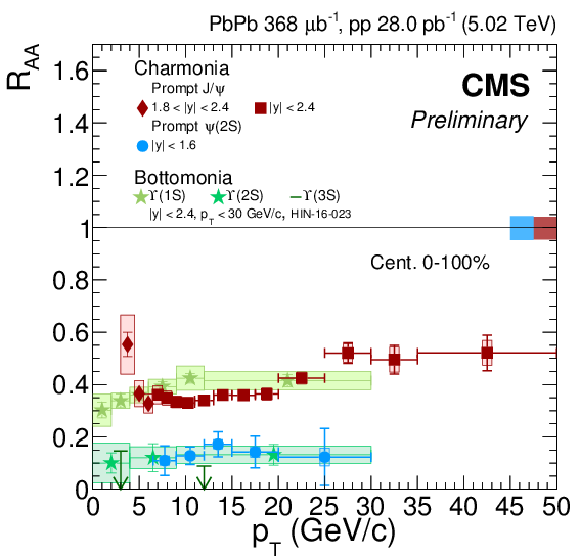
png pdf |
Additional Figure 1:
Nuclear modification factor of five prompt quarmonia as a function of pT at √sNN= 5.02TeV, integrated over centrality. |
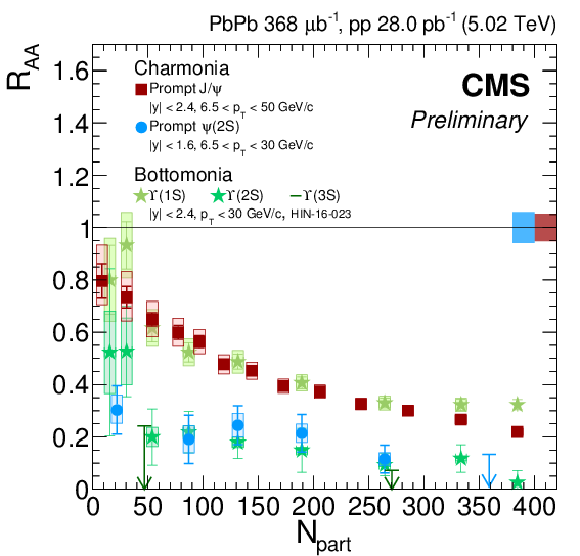
png pdf |
Additional Figure 2:
Nuclear modification factor of five prompt quarmonia as a function of centrality at √sNN= 5.02 TeV. While bottomonium measurements are inclusive in pT , they start at pT= 6.5 GeV/c for charmonia. |
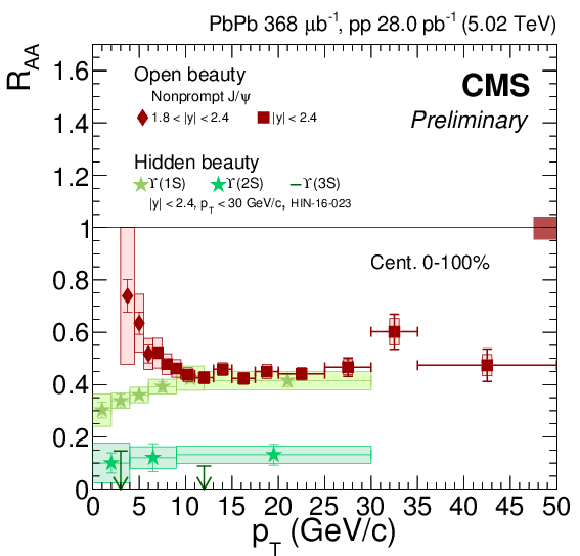
png pdf |
Additional Figure 3:
Nuclear modification factor of nonprompt J/ψ (open beauty) and bottomonia (hidden beauty) as a function of pT at √sNN= 5.02 TeV, integrated over centrality. |
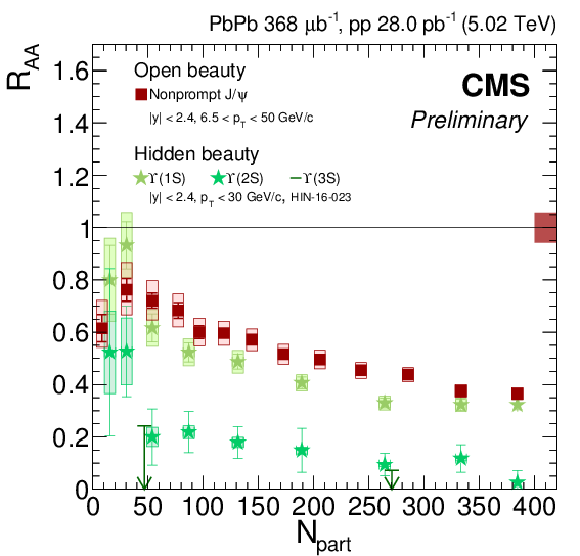
png pdf |
Additional Figure 4:
Nuclear modification factor of nonprompt J/ψ (open beauty) and bottomonia (hidden beauty) as a function of centrality at √sNN= 5.02 TeV. While bottomonium measurements are inclusive in pT , they start at pT= 6.5 GeV/c for nonprompt J/ψ . |
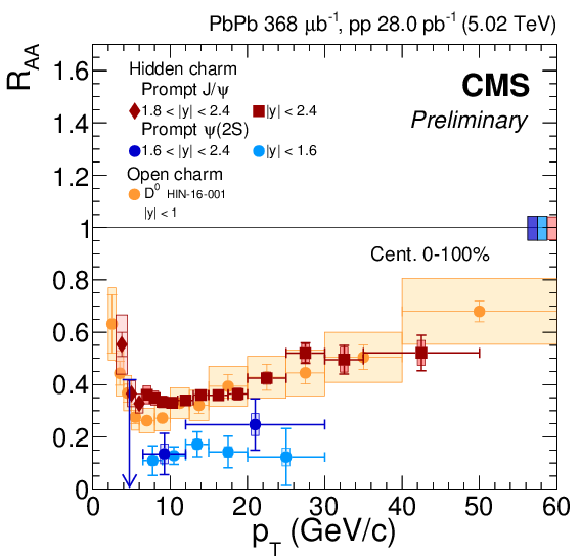
png pdf |
Additional Figure 5:
Nuclear modification factor of prompt J/ψ (hidden charm) and D mesons (open charm) as a function of pT at √sNN= 5.02 TeV, integrated over centrality. |
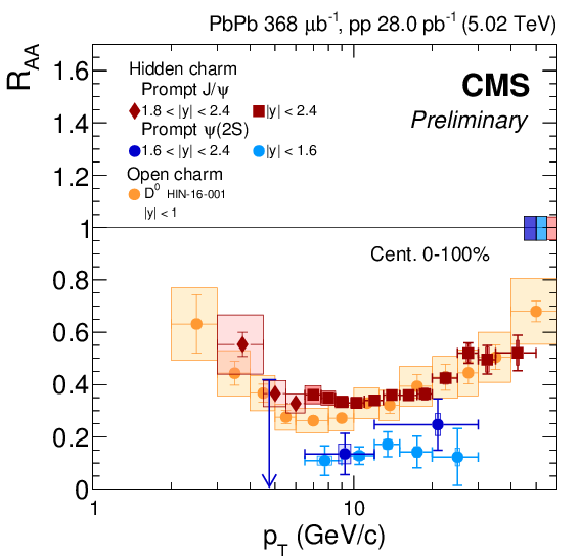
png pdf |
Additional Figure 6:
Nuclear modification factor of prompt J/ψ (hidden charm) and D mesons (open charm) as a function of pT at √sNN= 5.02 TeV, integrated over centrality. |
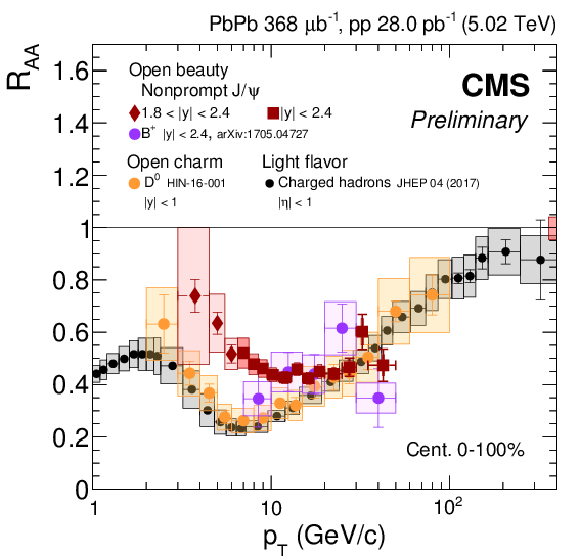
png pdf |
Additional Figure 7:
Nuclear modification factor of nonprompt J/ψ and B mesons (open beauty), of Dmesons (open charm), and of charged hadrons as a function of pT at √sNN= 5.02 TeV, integrated over centrality. |
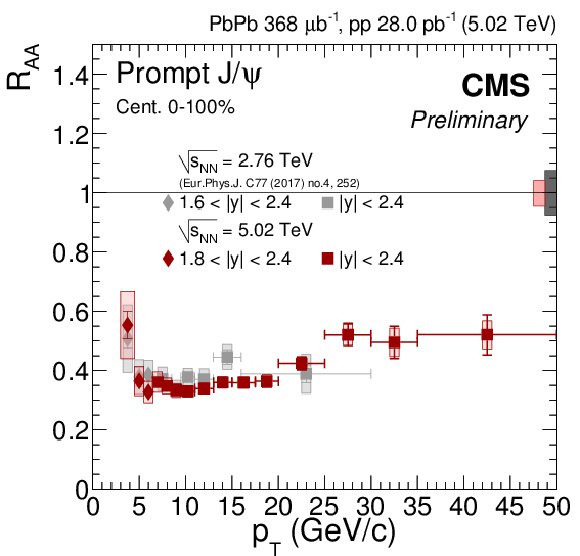
png pdf |
Additional Figure 8:
Nuclear modification factor of prompt J/ψ as a function of pT at √sNN= 5.02 TeV. The low pT measurements obtained at forward rapidity are overlaid to those at |y|< 2.4. Results obtained at √sNN= 2.76 TeV are overlaid for comparison. The bars (boxes) represent statistical (systematic) point-by-point uncertainties. The boxes plotted at RAA= 1 indicate the scale of the global relative uncertainties. |
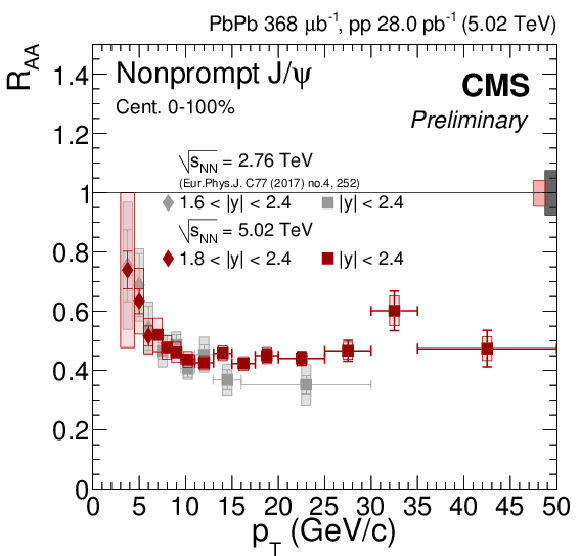
png pdf |
Additional Figure 9:
Nuclear modification factor of nonprompt J/ψ as a function of pT at √sNN= 5.02 TeV. The low pT measurements obtained at forward rapidity are overlaid to those at |y|< 2.4. Results obtained at √sNN= 2.76 TeV are overlaid for comparison. The bars (boxes) represent statistical (systematic) point-by-point uncertainties. The boxes plotted at RAA= 1 indicate the scale of the global relative uncertainties. |
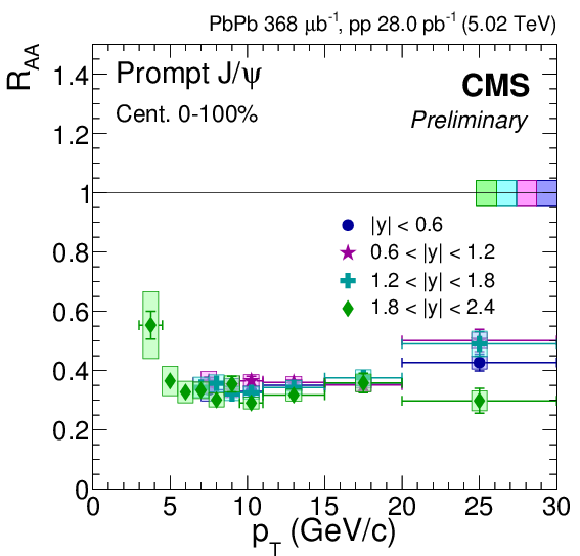
png pdf |
Additional Figure 10:
Nuclear modification factor of prompt J/ψ as a function of pT in four rapidity intervals. The bars (boxes) represent statistical (systematic) point-by-point uncertainties. The boxes plotted at RAA= 1 indicate the scale of the global relative uncertainties. |
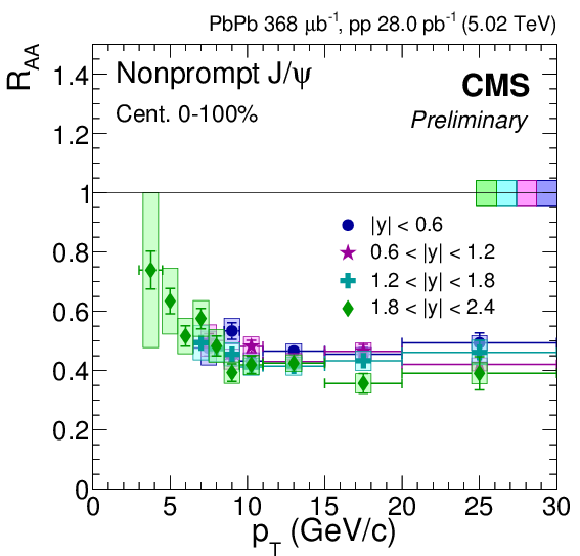
png pdf |
Additional Figure 11:
Nuclear modification factor of nonprompt J/ψ as a function of pT in four rapidity intervals. The bars (boxes) represent statistical (systematic) point-by-point uncertainties. The boxes plotted at RAA= 1 indicate the scale of the global relative uncertainties. |
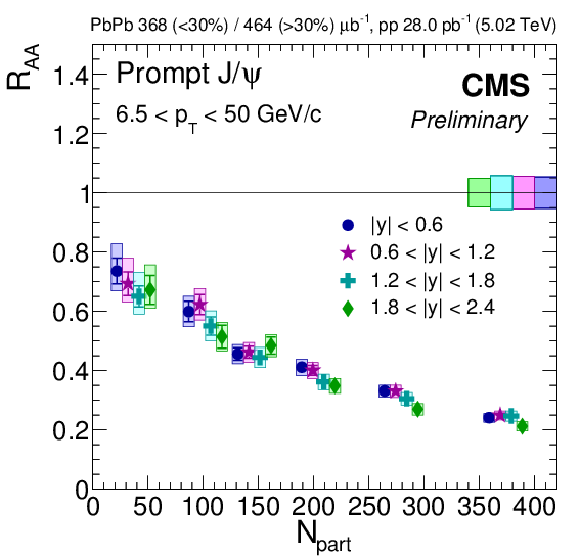
png pdf |
Additional Figure 12:
Nuclear modification factor of prompt J/ψ as a function of centrality in four rapidity intervals. Data points are slightly shifted horizontally for better visibility. The bars (boxes) represent statistical (systematic) point-by-point uncertainties. The boxes plotted at RAA= 1 indicate the scale of the global relative uncertainties. |
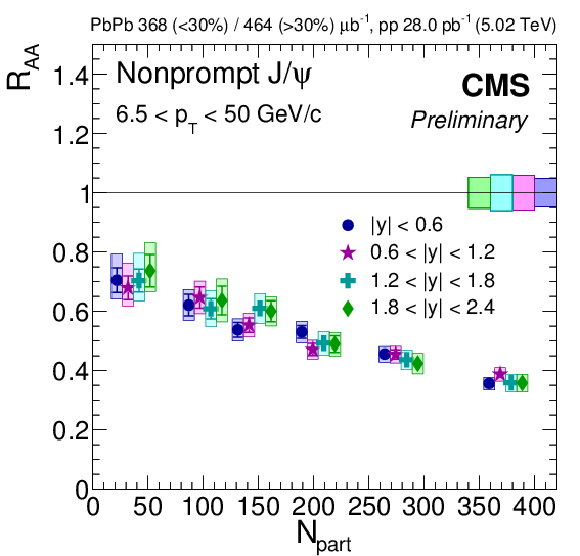
png pdf |
Additional Figure 13:
Nuclear modification factor of nonprompt J/ψ as a function of centrality in four rapidity intervals. Data points are slightly shifted horizontally for better visibility. The bars (boxes) represent statistical (systematic) point-by-point uncertainties. The boxes plotted at RAA= 1 indicate the scale of the global relative uncertainties. |
| References | ||||
| 1 | T. Matsui and H. Satz | J/ψ suppression by quark-gluon plasma formation | PLB 178 (1986) 416 | |
| 2 | NA50 Collaboration | A new measurement of J/ψ suppression in PbPb collisions at 158 GeV per nucleon | EPJC 39 (2005) 335 | hep-ex/0412036 |
| 3 | PHENIX Collaboration | J/ψ production versus centrality, transverse momentum, and rapidity in AuAu collisions at √sNN= 200 GeV | PRL 98 (2007) 232301 | nucl-ex/0611020 |
| 4 | CMS Collaboration | Observation of sequential Υ suppression in PbPb collisions | PRL 109 (2012) 222301 | CMS-HIN-11-011 1208.2826 |
| 5 | ALICE Collaboration | Suppression of Υ(1S) at forward rapidity in Pb-Pb collisions at √sNN= 2.76 TeV | PLB 738 (2014) 361 | 1405.4493 |
| 6 | P. Braun-Munzinger and J. Stachel | (Non) thermal aspects of charmonium production and a new look at J/ψ suppression | PLB 490 (2000) 196 | nucl-th/0007059 |
| 7 | R. L. Thews, M. Schroedter, and J. Rafelski | Enhanced J/ψ production in deconfined quark matter | PRC 63 (2001) 054905 | hep-ph/0007323 |
| 8 | ALICE Collaboration | J/ψ suppression at forward rapidity in PbPb collisions at √sNN= 2.76 TeV | PRL 109 (2012) 072301 | 1202.1383 |
| 9 | ALICE Collaboration | J/ψ suppression at forward rapidity in pb-pb collisions at √snn= 5.02 $ TeV | 1606.08197 | |
| 10 | CMS Collaboration | Suppression and azimuthal anisotropy of prompt and nonprompt J/ψ production in PbPb collisions at √sNN= 2.76 TeV | EPJC 77 (2017) 252 | CMS-HIN-14-005 1610.00613 |
| 11 | M. Strickland | Thermal Υ1S and χb1 suppression in √sNN= 2.76 TeV Pb-Pb collisions at the LHC | PRL 107 (2011) 132301 | 1106.2571 |
| 12 | X. Du and R. Rapp | Sequential Regeneration of Charmonia in Heavy-Ion Collisions | Nucl. Phys. A943 (2015) 147 | 1504.00670 |
| 13 | M. Spousta | On similarity of jet quenching and charmonia suppression | PLB 767 (2017) 10 | 1606.00903 |
| 14 | F. Arleo | Quenching of Hadron Spectra in Heavy Ion Collisions at the LHC | 1703.10852 | |
| 15 | LHCb Collaboration | Measurement of J/ψ production in pp collisions at √s= 7 TeV | EPJC 71 (2011) 1645 | 1103.0423 |
| 16 | CMS Collaboration | Prompt and non-prompt J/ψ production in pp collisions at √s= 7 TeV | EPJC 71 (2011) 1575 | CMS-BPH-10-002 1011.4193 |
| 17 | ATLAS Collaboration | Measurement of the differential cross-sections of inclusive, prompt and non-prompt J/ψ production in pp collisions at √s= 7 TeV | Nucl. Phys. B 850 (2011) 387 | 1104.3038 |
| 18 | CMS Collaboration | Performance of CMS muon reconstruction in pp collision events at √s= 7 TeV | JINST 7 (2012) P10002 | CMS-MUO-10-004 1206.4071 |
| 19 | CMS Collaboration | The CMS experiment at the CERN LHC | JINST 3 (2008) S08004 | CMS-00-001 |
| 20 | CMS Collaboration | Dependence on pseudorapidity and centrality of charged hadron production in PbPb collisions at √sNN= 2.76 TeV | JHEP 08 (2011) 141 | CMS-HIN-10-001 1107.4800 |
| 21 | M. L. Miller, K. Reygers, S. J. Sanders, and P. Steinberg | Glauber modeling in high-energy nuclear collisions | Ann. Rev. Nucl. Part. Sci. 57 (2007) 205 | nucl-ex/0701025 |
| 22 | CMS Collaboration | Charged-particle nuclear modification factors in PbPb and pPb collisions at √sNN= 5.02 TeV | JHEP 04 (2017) 039 | CMS-HIN-15-015 1611.01664 |
| 23 | T. Sj\"ostrand et al. | An Introduction to PYTHIA 8.2 | CPC 191 (2015) 159 | arXiv:1410.3012 |
| 24 | D. J. Lange | The EvtGen particle decay simulation package | NIMA 462 (2001) 152 | |
| 25 | I. P. Lokhtin and A. M. Snigirev | A model of jet quenching in ultrarelativistic heavy ion collisions and high-pT hadron spectra at RHIC | EPJC 45 (2006) 211 | hep-ph/0506189 |
| 26 | GEANT Collaboration | GEANT4 --- A simulation toolkit | NIMA 506 (2003) 250 | |
| 27 | M. J. Oreglia | A Study of the Reactions ψ′→γγψ | Ph.D. Thesis (1980) Appendix D | |
| 28 | M. Pivk and F. Le Diberder | sPlot: a statistical tool to unfold data distributions | physics/0402083 | |
| 29 | CMS Collaboration | Suppression of non-prompt J/ψ, prompt J/ψ, and Υ(1S) in PbPb collisions at √sNN= 2.76 TeV | JHEP 05 (2012) 063 | CMS-HIN-10-006 1201.5069 |
| 30 | CMS Collaboration | CMS Luminosity Calibration for the pp Reference Run at √s= 5.02 TeV | CMS-PAS-LUM-16-001 | CMS-PAS-LUM-16-001 |
| 31 | CMS Collaboration | Relative modification of prompt ψ(2s) and J/ψ yields from pp to PbPb collisions at √sNN= 5.02 TeV | PRL 118 (2017), no. 16, 162301 | CMS-HIN-16-004 1611.01438 |

|
Compact Muon Solenoid LHC, CERN |

|

|

|

|

|

|